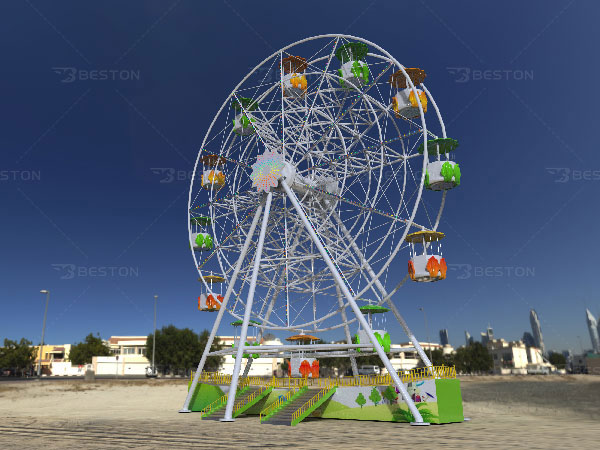Ferris wheels have been a staple in the world of amusement rides for generations. They offer riders a unique perspective, a thrilling experience, and a sense of nostalgia that has kept them popular in amusement parks, fairs, and other entertainment venues. While mini Ferris wheels and big Ferris wheels share a common design and purpose, they differ in several key aspects, including size, capacity, experience, and the overall impact on the rider. In this comparative analysis, we will explore the significant differences between these two types of Ferris wheels.
Size and Height
One of the most evident differences between mini Ferris wheels and big Ferris wheels is their size and height. Mini Ferris wheels are typically designed for children and families, with a smaller height and scale that allows them to fit comfortably within smaller amusement park settings or even in shopping malls. These mini Ferris wheels are often under 30 feet in height, making them accessible to a broader range of people.
In contrast, big Ferris wheels are designed to be colossal, iconic attractions. Some of the world’s most famous Ferris wheels, such as the London Eye and the Singapore Flyer, are enormous structures that can reach heights of over 500 feet. These colossal wheels provide riders with a breathtaking view of the surrounding landscape and often serve as landmarks in their respective cities.
Capacity
Mini Ferris wheels are typically designed for smaller groups and families. They have a limited number of passenger gondolas or seats, which can vary from a few to around a dozen. This design is perfect for providing a fun, intimate experience for a family or small group of friends, without the need for long queues.
On the other hand, big Ferris wheels are known for their high capacity. They can accommodate a significantly larger number of passengers in each rotation. These large Ferris wheel amusement rides for sale often have dozens of spacious gondolas or cabins, allowing them to cater to a more extensive range of visitors, including tourists, couples, and even corporate events.
Experience
The experience of riding a mini Ferris wheel differs significantly from that of a big Ferris wheel. Mini Ferris wheels are more child-friendly and less intimidating, making them suitable for riders of all ages, including young children. The rotations are often quicker and less high, offering a gentle, pleasant ride with a focus on fun rather than thrills.
Conversely, big Ferris wheels provide a more majestic and awe-inspiring experience. The slow, steady rotation of these wheels offers riders a sense of tranquility and a panoramic view of the surrounding area. The height and size of the wheel create a dramatic perspective and a breathtaking sense of elevation that can be both thrilling and contemplative. These big Ferris wheels are designed to provide a more mature and romantic experience, often including amenities like glass floors or climate-controlled cabins.

Location and Purpose
Mini Ferris wheels are commonly found in smaller amusement parks, family entertainment centers, and shopping malls. Their primary purpose is to entertain families and young children, while also serving as a supplementary attraction in these settings. Mini Ferris wheels also called kiddie Observation Wheel for sale, are often used to create a festive atmosphere and are integral to the overall ambiance of the venue.
Big Ferris wheels, on the other hand, are typically major attractions and are often placed in prominent, urban locations. They serve both as tourist attractions and landmarks in their respective cities. The London Eye, for example, has become an iconic symbol of London. Big Ferris wheels are designed to draw visitors and provide them with a unique perspective of the cityscape.
Impact and Cultural Significance
Big Ferris wheels often hold a special place in the hearts of the communities in which they are located. They are often associated with major events, celebrations, and city landmarks. These wheels can become symbols of a city’s progress, innovation, and cultural identity. In contrast, while mini Ferris wheels offer family-friendly entertainment, they do not typically have the same level of cultural significance or recognition.
At last, mini Ferris wheels and big Ferris wheels differ significantly in size, capacity, experience, location, and cultural significance. While mini Ferris wheels offer a lighthearted, family-oriented experience in smaller venues, big Ferris wheels provide a majestic and iconic experience that often defines the cityscape and attracts tourists from all over the world. Both types of Ferris wheels have their unique charm and purpose, catering to different audiences and creating distinct memories for riders of all ages.